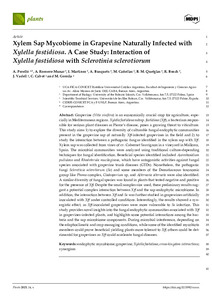Por favor, use este identificador para citar o enlazar este ítem:
https://repositorio.uca.edu.ar/handle/123456789/20826| Campo DC | Valor | Lengua/Idioma |
|---|---|---|
| dc.contributor.author | Perelló, A. | es |
| dc.contributor.author | Romero Munar, A. | es |
| dc.contributor.author | Martinez, I. | es |
| dc.contributor.author | Busquets, A. | es |
| dc.contributor.author | Cañellas, M. | es |
| dc.contributor.author | Quetglas, B. M. | es |
| dc.contributor.author | Bosch, R. | es |
| dc.contributor.author | Vadell, J. | es |
| dc.contributor.author | Cabot, C. | es |
| dc.contributor.author | Gomila, M. | es |
| dc.coverage.spatial | España | es |
| dc.date.accessioned | 2025-11-06T20:10:55Z | - |
| dc.date.available | 2025-11-06T20:10:55Z | - |
| dc.date.issued | 2025 | - |
| dc.identifier.issn | 2223-7747 | - |
| dc.identifier.uri | https://repositorio.uca.edu.ar/handle/123456789/20826 | - |
| dc.description.abstract | Grapevine (Vitis vinifera) is an economically crucial crop for agriculture, especially in Mediterranean regions. Xylella fastidiosa subsp. fastidiosa (Xff), a bacterium responsible for serious plant diseases as Pierce’s disease, poses a growing threat to viticulture. This study aims 1) to explore the diversity of culturable fungal endophytic communities present in the grapevine sap of naturally Xff-infected grapevines in the field and 2) to study the interaction between a pathogenic fungus identified in the xylem sap with Xff. Xylem sap was collected from vines of cv. Cabernet Sauvignon in a vineyard in Mallorca, Spain. The microbial communities were analyzed using traditional culture-depending techniques for fungal identification. Beneficial species identified included Aureobasidium pullulans and Rhodotorula mucilaginosa, which have antagonistic activities against fungal species associated with grapevine trunk diseases (GTDs). Nonetheless, the pathogenic fungi Sclerotinia sclerotiorum (Ss) and some members of the Dematiaceous taxonomic group like Phoma complex, Cladosporium sp, and Alternaria alternata were also identified. A similar diversity of fungal species was found in plants that tested negative and positive for the presence of Xff. Despite the small samples size used, these preliminary results suggest a potential complex interaction between Xff and the sap endophytic microbiome. In 28 addition, the interaction between Xff and Ss was further studied in grapewines artificially inoculated with Xff under controlled conditions. Interestingly, the results showed a synergistic effect, as Xff-inoculated grapevines were more vulnerable to Ss infection. This study provides novel insights into the fungal endophytic communities associated with Xff in grapevines-infected plants, and highlights some potential interactions among the bacteria and the sap microbiome components. During microbial interference, depending on the edaphoclimatic and crop managing conditions, while some of the identified mycobiota members could prove beneficial yielding plants more tolerant to Xff, others could be detrimental for grapevines as Xff could accelerate fungal diseases. | es |
| dc.format | application/pdf | es |
| dc.language.iso | spa | es |
| dc.publisher | MDPI | es |
| dc.rights | Atribución-NoComercial-CompartirIgual 4.0 Internacional | * |
| dc.rights.uri | http://creativecommons.org/licenses/by-nc-sa/4.0/ | * |
| dc.source | Plants. 2025, 14 | es |
| dc.subject | AGRICULTURA | es |
| dc.subject | CULTIVO ALIMENTICIO | es |
| dc.subject | VITICULTURA | es |
| dc.subject | MEJORA DE CULTIVOS | es |
| dc.title | Xylem Sap Mycobiome in Grapevine Naturally Infected with 2 Xylella fastidiosa. A Case Study: Interaction of 3 Xylella fastidiosa with Sclerotinia sclerotiorum | es |
| dc.type | Artículo | es |
| uca.issnrd | 1 | es |
| uca.affiliation | Fil: Perelló, A. Pontificia Universidad Católica Argentina. Facultad de Ingeniería y Ciencias Agrarias; Argentina | es |
| uca.affiliation | Fil: Romero Munar, A. University of the Balearic Islands. Department of Biology; España | es |
| uca.affiliation | Fil: Martinez, I. Universidad Nacional de La Plata; Argentina | es |
| uca.affiliation | Fil: Martinez, I. CONICET; Argentina | es |
| uca.affiliation | Fil: Busquets, A. Universitat de les Illes Balears. Scientific-Tecnhical Services; España | es |
| uca.affiliation | Fil: Cañellas, M. University of the Balearic Islands. Department of Biology; España | es |
| uca.affiliation | Fil: Quetglas, B. M. University of the Balearic Islands. Department of Biology; España | es |
| uca.affiliation | Fil: Bosch, R. University of the Balearic Islands. Department of Biology; España | es |
| uca.affiliation | Fil: Vadell, J. University of the Balearic Islands. Department of Biology; España | es |
| uca.affiliation | Fil: Cabot, C. University of the Balearic Islands. Department of Biology; España | es |
| uca.affiliation | Fil: Gomila, M. University of the Balearic Islands. Department of Biology; España | es |
| uca.version | publishedVersion | es |
| item.fulltext | With Fulltext | - |
| item.grantfulltext | open | - |
| item.languageiso639-1 | es | - |
| Aparece en las colecciones: | Artículos | |
Ficheros en este ítem:
| Fichero | Descripción | Tamaño | Formato | |
|---|---|---|---|---|
| xylem-sap-mycobiome.pdf | 1,27 MB | Adobe PDF |  Visualizar/Abrir |
Este ítem está sujeto a una Licencia Creative Commons

